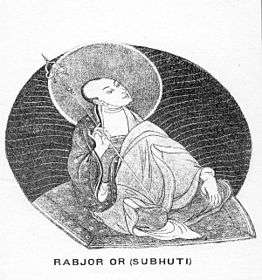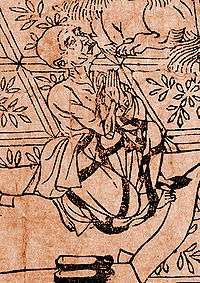Subhuti


Subhūti (Pali: Subhūti; Chinese: 须菩提; pinyin: Xūpútí) was one of the Ten Great Śrāvakas of Gautama Buddha, and foremost in giving gifts. In Prakrit and Pāli, his name literally means "Good Existence" (su: "good", bhūti: "existence"). He is also sometimes referred to as "Elder Subhūti" (Subhūti Thera). He was a contemporary of such famous arahants as Śāriputra, Mahākāśyapa, Maudgalyayana, Mahākātyāyana and Ānanda.
In Theravada Buddhism
In Theravada Buddhism, Subhūti is famed as the monk who was most worthy of gifts due to his practice of absorption on loving-kindness (mettā-jhāna) before receiving almsfood.
He was the son of Sumanaseṭṭhī and the younger brother of Anāthapiṇḍika. On the day of the dedication of Jetavana, he heard the Buddha teach and left the world. After ordination he mastered the two categories of Vinaya rules, and, after obtaining a subject for meditation, lived in the forest. There he developed insight, and attained Arahantship on the basis of mettā-jhāna. Teaching the Dhamma without distinction or limitation, he was declared chief of those who lived remote and in peace (araṇavihārīnaṃ aggo), and of those who were worthy of gifts (dakkhiṇeyyānaṃ) (A.i.24; cf. Ud.vi.7, where the Buddha commends his proficiency in meditation). It is said that when he went begging for alms he would develop mettā-jhāna at each door, hence every gift made to him was of the highest merit. In the course of his travels he came to Rājagaha, and Bimbisāra promised to build him a dwelling-place. However, the king forgot his promise, and Subhūti meditated in the open air. There was no rain, and, discovering the cause, the king had a leaf hut built for him. As soon as Subhūti entered the hut and seated himself cross-legged on the bed of hay, rain began to fall.[1]
In Mahāyāna Buddhism
Among the Mahāyāna traditions, Subhūti is perhaps best known as the disciple with whom the Buddha speaks when imparting the Diamond Sūtra (Sanskrit: Vajracchedikā Prajñāpāramitā Sūtra, Chinese: 金剛經 or 金剛般若經), an important teaching within the Prajñāpāramitā genre. This, along with the Heart Sūtra (Sanskrit: Prajñāpāramitā Hṛdaya, Chinese: 心經 or 般若心經), is one of the most well-known sūtras among both practitioners and non-practitioners of Buddhism. Subhūti is also responsible for much of the exposition in earlier Prajñāpāramitā sūtras.[2]
In the Lotus Sutra (Sanskrit: Saddharma Puṇḍarīka Sūtra, Chinese: 法華(花)經 or 妙法蓮華(花)經), Chapter 6 (Bestowal of Prophecy), the Buddha bestows prophecies of enlightenment on Subhūti, along with other śrāvakas such as Mahākāśyapa, Mahākātyāyana, and Mahāmaudgalyāyana.
In Zen writings
In Zen Buddhism, Subhūti appears in several koans, such as this one:[3]
One day, in a mood of sublime emptiness, Subhuti was resting underneath a tree when flowers began to fall about him. "We are praising you for your discourse on emptiness," the gods whispered to Subhuti. "But I have not spoken of emptiness," replied Subhuti. "You have not spoken of emptiness, we have not heard emptiness," responded the gods. "This is the true emptiness." The blossoms showered upon Subhuti as rain.
Lineage of the Panchen Lamas
In the lineage of the Panchen Lamas of Tibet there were considered to be four "Indian" and three Tibetan incarnations of Amitabha Buddha before Khedrup Gelek Pelzang, who is recognised as the first Panchen Lama. The lineage starts with Subhuti.[4][5]
In Chinese literature
A character based on Subhūti appears in the Chinese classical novel Journey to the West, as the teacher of the Monkey King Sun Wukong.[6] The story of Sun Wukong first meeting Subhūti was a play on the Zen story of Huineng meeting Hongren, as told in the Platform Sūtra of Zen Buddhism. Because of the role that Subhūti plays in the story, his name has remained familiar in Chinese culture.[7]
Footnotes
- ↑ "Dictionary of Pali Proper names". Association for Insight Meditation. Retrieved 26 March 2017.
- ↑
- Lopez, Donald S., Jr. The Heart Sutra Explained: Indian and Tibetan Commentaries (1988) State University of New York Press. ISBN 0-88706-589-9 p. 7
- ↑ Reps, Paul and Nyogen Senzaki. Zen Flesh, Zen Bones: A Collection of Zen and Pre-Zen Writings. Rutland, Vermont: Tuttle, 2008.
- ↑ Stein, R. A. Tibetan Civilization, (1972) p. 84. Stanford University Press, Stanford, California. ISBN 0-8047-0806-1 (cloth); ISBN 0-80-470901-7.
- ↑ Das, Sarat Chandra. Contributions on the Religion and History of Tibet (1970), pp. 81-103. Manjushri Publishing House, New Delhi. First published in the Journal of the Asiatic Society of Bengal, Vol. LI (1882).
- ↑ Ping Shao, "Huineng, Subhūti, and Monkey's Religion in 'Xiyou ji'", The Journal of Asian Studies, Vol. 65, No. 4 (Nov., 2006), pp. 713-740
- ↑ Nan Huaijin. Diamond Sutra Explained. Florham Park: Primordia, 2004. Page 25.